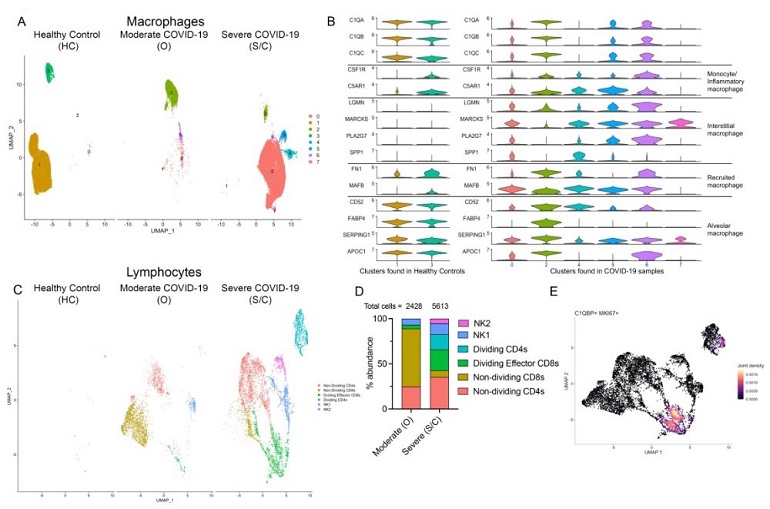Monocyte production of C1q enhances CD8+ T cell function against respiratory viruses
Nikhil Prasad Fact checked by:Thailand Medical News Team Jul 24, 2024 1 year, 3 months, 3 weeks, 6 days, 18 hours, 5 minutes ago
Immunology News: Researchers from the University of Pittsburgh School of Medicine-USA have made a significant breakthrough in understanding how the body fights off respiratory viral infections. This
Immunology News report will explore their findings on the role of a protein called C1q, produced by monocytes, in enhancing the function of CD8+ T cells, crucial components of our immune system.
 Transcriptional evidence C1q:gC1qR axis activation in COVID-19 cases. A.) UMAP ofmacrophage/monocyte populations identified in bronchoalveolar lavage fluid from healthy controls (HC),moderate COVID-19 cases (O), or severe COVID-19 cases (S/C) demonstrating 8 clusters. B.) Stacked violinplots showing expression levels of C1QA, C1QB, C1QC and various transcriptional markers of macrophagestates from clusters identified from HC (left) or clusters from COVID-19 patients (right). C.) UMAPs of thesubset of T cells from overall dataset separated by disease state. D.) Abundance plots of various subsets inmoderate vs. severe COVID-19 disease. E.) Co-expression of MKI67 (marker of rapid division) and C1QBP islargely confined to rapidly dividing CD8 cluster
The Body’s Defense System
Transcriptional evidence C1q:gC1qR axis activation in COVID-19 cases. A.) UMAP ofmacrophage/monocyte populations identified in bronchoalveolar lavage fluid from healthy controls (HC),moderate COVID-19 cases (O), or severe COVID-19 cases (S/C) demonstrating 8 clusters. B.) Stacked violinplots showing expression levels of C1QA, C1QB, C1QC and various transcriptional markers of macrophagestates from clusters identified from HC (left) or clusters from COVID-19 patients (right). C.) UMAPs of thesubset of T cells from overall dataset separated by disease state. D.) Abundance plots of various subsets inmoderate vs. severe COVID-19 disease. E.) Co-expression of MKI67 (marker of rapid division) and C1QBP islargely confined to rapidly dividing CD8 cluster
The Body’s Defense System
Respiratory viral infections, like those caused by the human metapneumovirus (HMPV) and other common viruses, can lead to severe illness and even death. The body’s immune system relies on various cells and proteins to combat these infections. Among these immune cells, CD8+ T cells play a critical role in identifying and destroying infected cells. However, their efficiency can be influenced by other immune components, including proteins produced by monocytes.
The Role of Monocytes and C1q
Monocytes are a type of white blood cell that can differentiate into various cells, including macrophages, which help fight infections. The study focused on a specific protein produced by monocytes, known as C1q. C1q is part of the complement system, a group of proteins that enhance the ability of antibodies and phagocytic cells to clear pathogens.
Key Findings of the Study
The researchers discovered that during respiratory viral infections, monocytes produce C1q, which significantly enhances the function of CD8+ T cells. Here’s a detailed look at the study’s key findings:
-Recruitment of C1q-Expressing Monocytes
Using a mouse model of HMPV infection, the researchers observed that the infection led to the recruitment of a specific population of monocytes that produce C1q. This recruitment coincided with the activation of CD8+ T cells, which are essential for clearing the virus from the lungs.
-Impact of C1q on CD8+ T Cells
To understand the role of C1q, the researchers used genetically modified mice that lacked the abili
ty to produce C1q. These mice showed a significant reduction in CD8+ T cell function compared to normal mice. The CD8+ T cells in these C1q-deficient mice had lower levels of key effector molecules such as granzyme B, IL-2, and interferon-gamma (IFN-γ), which are crucial for their antiviral activity.
-The Mechanism of C1q Action
Further experiments revealed that CD8+ T cells express a receptor called gC1qR, which binds to C1q. When this receptor was blocked, CD8+ T cells showed impaired function, similar to what was observed in C1q-deficient mice. This finding indicates that the interaction between C1q and its receptor on CD8+ T cells is critical for their optimal function during a viral infection.
Human Relevance of the Findings
The researchers also examined lung tissue samples from children who had died from severe respiratory viral infections, including those caused by HMPV and COVID-19. They found that these tissues had high levels of C1q and its receptor gC1qR, suggesting that the C1q-mediated enhancement of CD8+ T cell function observed in mice also occurs in humans.
Implications for Future Research and Treatment
These findings have several important implications:
-Understanding Immune Interactions: The study highlights a previously unknown interaction between monocytes and CD8+ T cells mediated by C1q, offering new insights into how the immune system coordinates its response to respiratory viral infections.
-Potential Therapeutic Targets: The C1q-gC1qR axis could be a potential target for new therapies aimed at boosting immune responses against respiratory viruses, particularly in vulnerable populations such as the elderly and those with compromised immune systems.
-Broad Applicability: Given the similarities between the immune responses to different respiratory viruses, this mechanism could be relevant for a wide range of viral infections, including influenza and COVID-19.
Conclusion
This groundbreaking research conducted by scientists at the University of Pittsburgh School of Medicine sheds light on the critical role of C1q in enhancing the function of CD8+ T cells during respiratory viral infections. By improving our understanding of these immune interactions, the study paves the way for developing new treatments that could enhance our ability to fight off these infections more effectively.
The study findings were published in the peer-reviewed journal American Journal of Respiratory Cell and Molecular Biology.
https://www.atsjournals.org/doi/abs/10.1165/rcmb.2024-0004OC
For the latest
Immunology News, keep on logging to Thailand Medical News.
Read Also:
https://www.thailandmedical.news/news/new-immune-protein-ubxn3b-identified-as-playing-a-key-role-in-b-cell-development-and-immunity
https://www.thailandmedical.news/news/il-27-dual-role-as-either-a-preventor-or-promoter-of-covid-19
